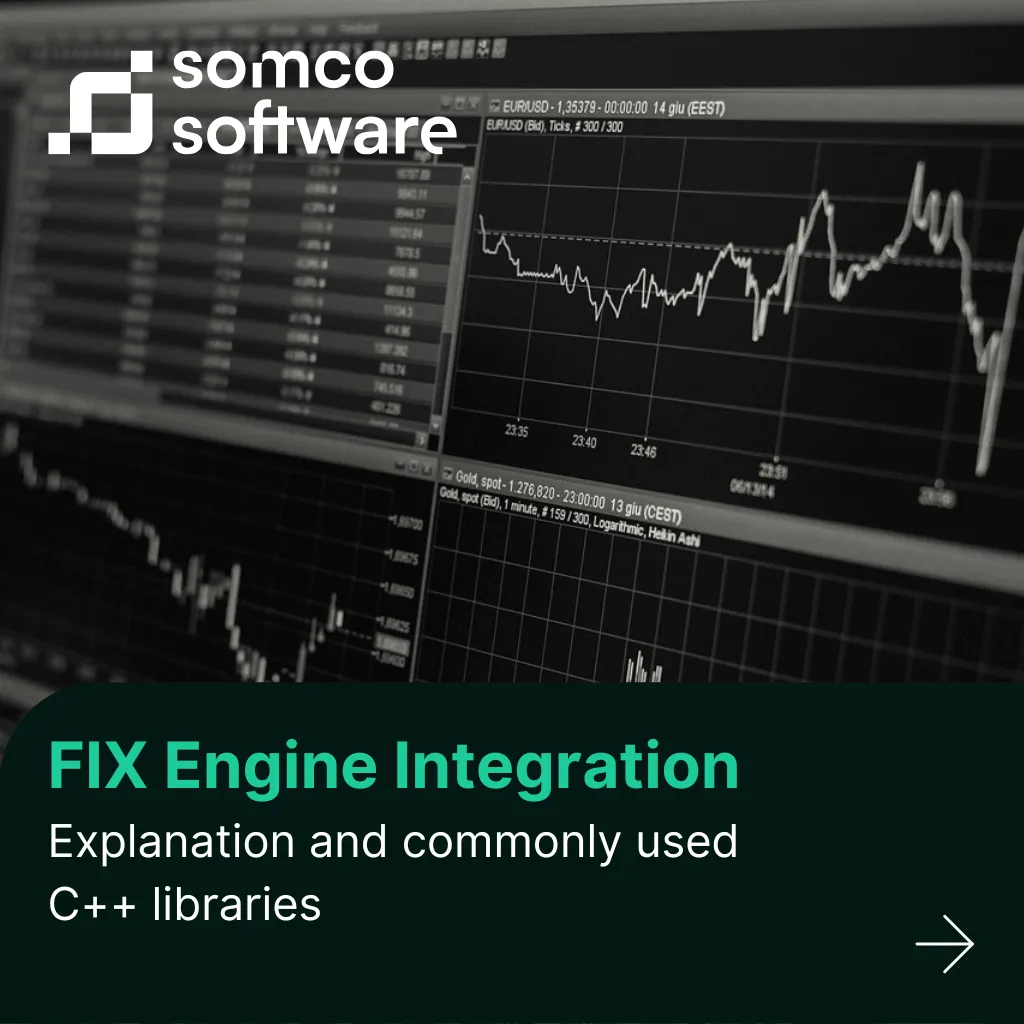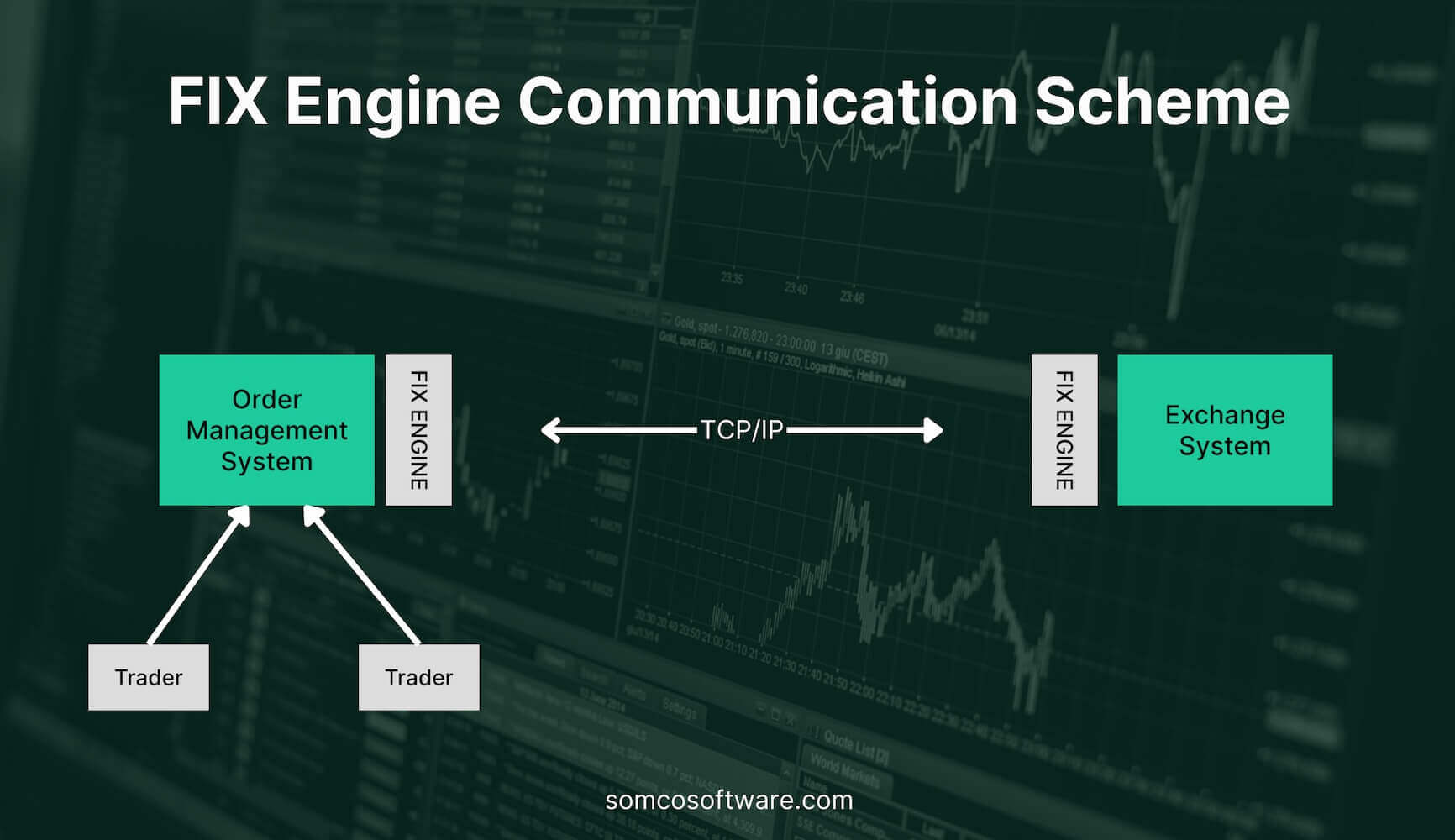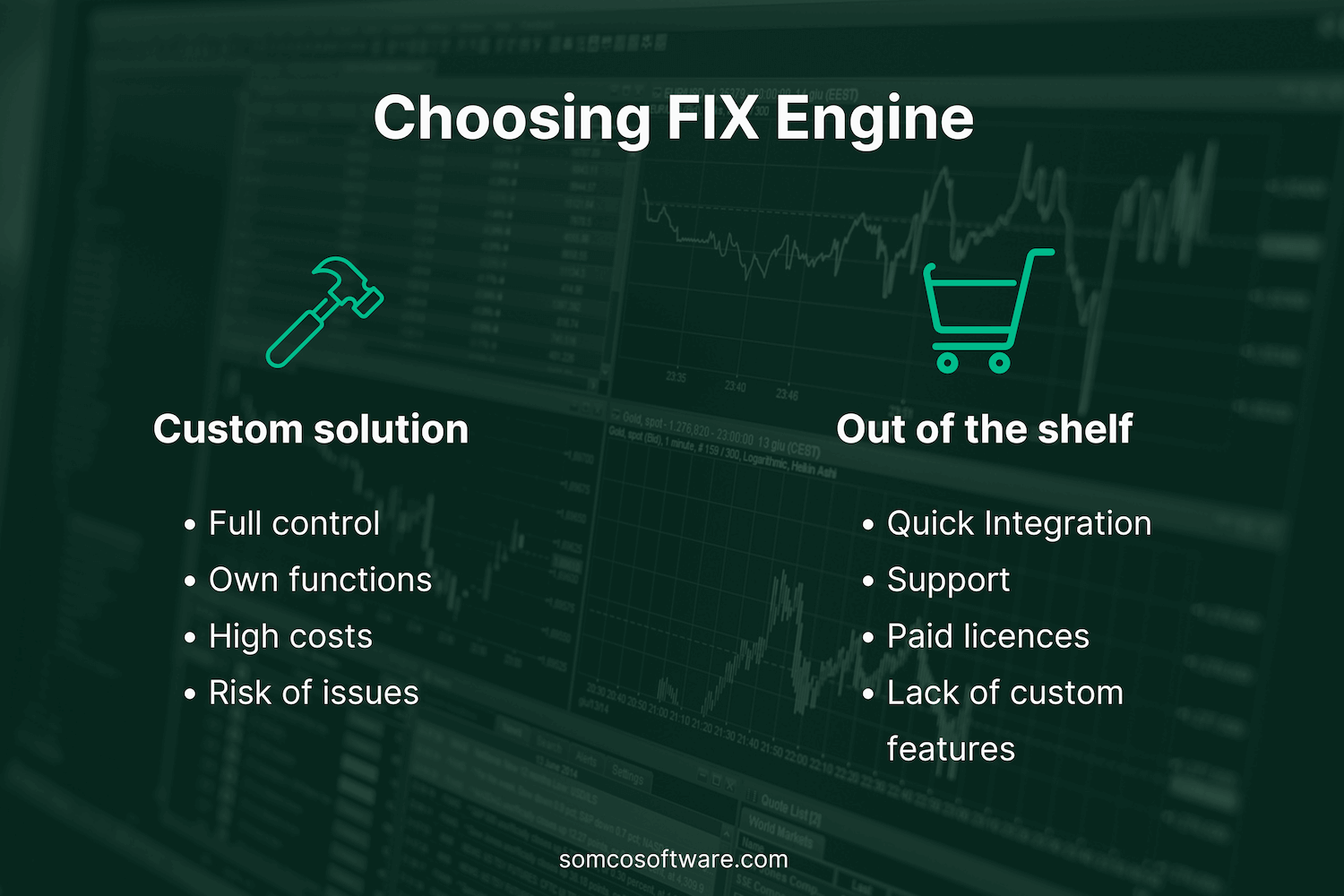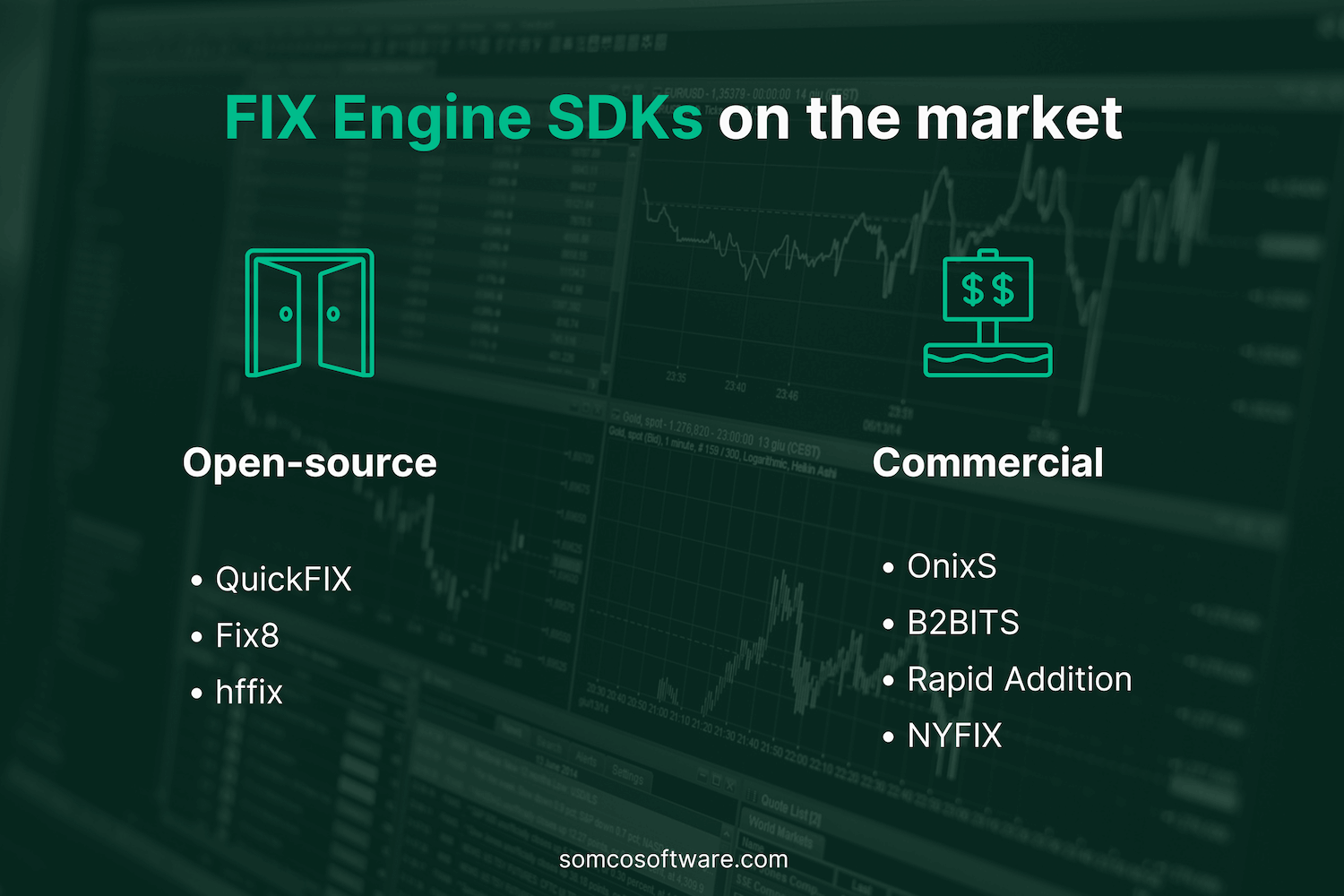
Rust vs C++: Successor or Pretender? Honest Opinion of our CTO
As systems grow more complex and reliability becomes mission-critical, developers face an old but still unsolved dilemma: should you build […]

Financial Information eXchange (FIX) is the global standard for electronic trading. From equities to FX, FIX enables systems across capital markets to exchange orders, executions and market data in real time. But while the protocol is standardized, integrating it into real world systems is a technical and business challenge.
That’s why understanding how FIX engines work—and how to implement them reliably and efficiently—is key for any firm building or upgrading trading infrastructure.
If you’re a CTO, IT lead or architect in the finance sector, this guide will help you:
Need help with FIX integration or optimizing your connectivity stack?
Let’s talk about how we can support your team.
The FIX protocol is an industry standard message format for the electronic exchange of trading information. Since its inception in the 90s, FIX has become the global messaging standard for financial trades, used across equities, fixed income, foreign exchange and more. It standardises how trades are communicated – for example, defining message types like New Order, Execution Report, Quote Request, etc., with each message composed of standard field tags and values. This common language allows disparate systems to talk to each other without custom interfaces.
A FIX engine, on the other hand, is the software that actually runs the FIX protocol within your systems. It maintains the session with counterparties and ensures all messages conform to FIX standards.
As the FIX Trading Community defines it, “a FIX engine is a piece of software that manages a network connection, creates and parses outgoing and incoming messages, and recovers if something goes wrong”.
It implements both the session layer (handling logon, heartbeat, sequence numbers, reconnect logic) and the application layer (handling the trading messages themselves).
In a typical electronic trading setup, there will be two FIX engines communicating — one on the client side and one on the broker or exchange side, establishing a FIX session and then exchanging application messages (orders, cancels, executions, etc.). Without a FIX engine, a trading system would be unable to “speak” the FIX protocol; with it, the system gains access to the broad FIX connectivity network of brokers, exchanges, and clients. This capability effectively enables FIX to fix enable trading across various markets, serving as a foundation for interoperable electronic communication.

Integrating a FIX engine into a financial system brings significant business and operational benefits by leveraging the FIX standard:
| Benefit Area | Description |
|---|---|
| Universal Market Connectivity | FIX provides an open, vendor neutral connection to multiple counterparties, reducing integration complexity and speeding up onboarding of new brokers/clients. |
| STP and Operational Efficiency | The FIX standard automates order flows (from creation to settlement), eliminating manual steps, reducing errors and accelerating trade execution. |
| Lower Integration Costs and Fewer Errors | Using a common protocol reduces costs, enables reuse of infrastructure and minimises risks associated with manual data handling. |
| Regulatory Compliance and Transparency | Standardised messages simplify monitoring, reporting and compliance by providing consistent, rich data across the firm. |
| Industry Standard and Network Effects | FIX is widely adopted, compatible with many trading systems and supported by a large expert community, so access to a broad ecosystem. |

Because of these benefits, FIX engines are used in many trading system scenarios. Some typical use cases are:
Note that in many trading workflows, FIX is used on the client and broker side, but the internal systems of an exchange might use a different high-speed protocol. Nonetheless, FIX is the standard interface at the boundaries between firms, so interoperability.
Integrating a FIX engine into your financial system requires planning on both the business and technical sides. Here we look at how to do it:
First, decide whether to use a third-party FIX engine or build one in-house. Most firms choose to buy or adopt an existing engine rather than build from scratch, as implementing the FIX protocol is complex. Many commercial FIX engines come with out of the box optimisations and certification for major exchanges, so less integration work. Building FIX from scratch is hard and error prone, so using a proven engine (open-source or commercial) speeds up the project. When evaluating engines, consider: supported FIX versions, performance (throughput/latency), supported platforms/languages, reliability and vendor support.

Decide how the FIX engine will be deployed in your architecture. You have two main integration models:
Prepare the connectivity infrastructure for FIX. FIX engines communicate over TCP/IP (often on specific ports over VPNs or dedicated lines). You’ll need network routes and possibly VPN connections to each counterparty (broker or venue). Most trading infrastructures use FIX engines that can manage multiple sessions with different counterparties simultaneously, so less gateways are needed. Plan firewall rules to allow FIX session traffic out of your environment.
High availability is key here: since FIX is used for live trading, you should have redundancy in networks and systems. Many firms have secondary FIX connections or standby engines to failover if the primary connection or engine fails. These architectures often use load balancing to distribute traffic and improve resilience under heavy trading conditions. Collocation might also be a factor – if low latency is important, hosting your FIX engine server in a data center close to the exchange or broker reduces round-trip times.
Once the engine is chosen and set up, the integration involves significant configuration and some coding:
Before going live, a FIX integration must be thoroughly tested with each counterparty. Despite FIX being a standard, each trading partner’s FIX interface can have unique quirks or requirements, as mentioned above.
While the benefits of FIX integration are clear, there are pitfalls to be aware of. Some of the common challenges are:

There are many FIX engines available – from open-source projects to high-end commercial offerings. Their use in trading infrastructure is just one example of how C++ powers low-latency and reliable solutions across finance, a topic we explored in more detail in Modern C++ in Finance: Building Low-Latency, High-Reliability Systems.
Here are some widely used FIX engines, including those favored for C++ integration:
QuickFIX is a widely used open-source FIX engine, originally written in C++. It has been ported or wrapped in other languages (QuickFIX/J for Java, QuickFIX/n for .NET, QuickFIX/Go, etc.), making it very flexible. QuickFIX is free and open source (BSD license) and supports FIX 4.0 up through 5.0 with a robust feature set. Performance is generally good for moderate volumes, but some high-volume shops find it requires tuning or might opt for commercial alternatives for ultra-low latency. QuickFIX stores messages to files by default and provides callback hooks for application logic. Its flexible API allows building custom FIX applications that integrate directly into trading workflows. It’s a good starting point for FIX integration in C++ if budget is a major concern.
B2BITS (a unit of EPAM Systems) offers the FIX Antenna engine in C++ as well as Java and .NET. FIX Antenna C++ is known for its high performance, targeting low-latency trading; the vendor claims processing rates over 100k messages per second on a single CPU core.
OnixS is a popular provider of FIX Engine SDKs. Their engines are designed for consistent low latency and aimed at mission-critical trading systems. OnixS provides native libraries in C++, .NET, and Java. They emphasize easy API integration and boast “certified” readiness for many exchanges.
Fix8 is a lesser-known open-source C++ FIX engine/library. It’s designed for performance and flexibility (template-driven code generation for FIX messages, etc.). It could be an option for developers who want an open-source engine with a more modern C++ design, though the community is smaller.
Several other FIX engines have been used in the industry, though they are less common in new C++ deployments. NYFIX Appia (Broadridge) has been around for a long time and is known for reliability and seamless integration with the NYFIX network, while CameronFIX (now part of Itiviti) was popular in the 2000s for strict FIX compliance and configurability. Rapid Addition offers high-throughput engines with a focus on enterprise integration, especially in European markets. There are also niche offerings such as InfoReach, Flyer, cloud-based solutions and FPGA-accelerated FIX engines, reflecting the diversity of the FIX ecosystem.

Finally, to ensure a smooth integration and ongoing reliable operations, here are best practices and recommendations for FIX engine integration:
Integrating a FIX engine into your trading architecture is both a business enabler and a technical challenge. From a CEO/CTO perspective it opens up market access, client connectivity and operational efficiency (fewer errors, lower costs) in trade processing. For the technology teams it’s a powerful but complex component that needs to be expertly configured and managed.
The FIX protocol is the “universal language” of electronic trading and a good FIX engine lets your firm speak that language. By understanding the use cases, choosing the right engine and following best practices you can use FIX to streamline your trading operations and connect to the financial markets. In the fast-paced world of capital markets a robust FIX engine integration is not just plumbing – it’s a strategic asset to stay connected and competitive.
Let's face it? It is a challenge to get top Qt QML developers on board. Help yourself and start the collaboration with Somco Software - real experts in Qt C++ framework.
Discover our capabilities
As systems grow more complex and reliability becomes mission-critical, developers face an old but still unsolved dilemma: should you build […]

In the projects we deliver at Somco for medical device manufacturers, the topic of SOUP almost always comes up. Whether […]

As applications get more complex and performance expectations rise, multithreading becomes essential. In my experience, Qt provides a powerful — […]